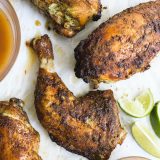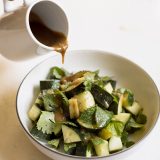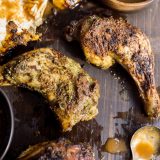My tour of Chiang Mai started minutes after leaving the airport. Our van pushed through crowded streets, swarms of bicycles, zippy three-wheeled tuk tuks and the press of nightlife under the bright fluorescent lights of sidewalk eateries.
The hotel was an oasis—a giant tamarind tree swelled up and out of the central courtyard—and breakfast was plentiful: tropical fruit, eggs and sticky rice in banana leaves.
The next day, we toured the city’s restaurants, starting with a grilled chicken establishment that opened out onto the sidewalk, its 15-foot-long grill just feet from the busy street. Two young grill chefs wore white cotton masks to filter out the charcoal smoke, like emergency workers at a disaster scene. Like many Thai restaurants, the vendor’s name told its story: Kai Yang Wichian Buri, or “grilled chicken from the district of Wichian Buri.” But the name was not the captivating part.
Each spatchcocked bird was affixed with two bamboo skewers set in a V-shape. They were used first for turning the chicken on the grill, then elevating it above the heat either at a 45-degree angle during cooking or totally perpendicular when done. The grill is the classic brazier used by countless American fire departments to do chicken suppers; it allows cooks to start by crisping the skin with a hot fire, then moving the chicken up and away from the heat for slower cooking. Simple but brilliant. And in this establishment, a thick layer of ash covered the 150 pounds of charcoal, which both moderates the heat and prevents flare-ups.
Kai Yang Wichian Buri was true to the old ways. The result was, as I soon discovered, the best chicken I had ever eaten.
A word about the definition of “restaurant” in this context. Think of it as a large impromptu tent, nothing fancy or expensive. Food is stored in repurposed plastic buckets or cooked in large battered pots, all managed by a bustle of cooks who really know their stuff. Watching them use a large wooden mortar and pestle to make papaya salad was an education. And that’s what makes eating in Chiang Mai fun—no hallowed culinary temples here. Temples are for meditation, not dinner.
Preparations for the chicken started the day before with a marinade of fish sauce, coconut milk, lemon grass, crushed coriander and peppercorns, garlic, cilantro root, palm sugar and perhaps a touch of MSG, as well. (MSG, by the way, is a respectable ingredient in this part of the world.)
Andy and I sat down mid-morning to try the finished product along with the mouth-searing papaya salad. I was surprised the marinade had actually flavored the chicken—something that rarely works well at home.
The next surprise was the barbecue sauce, a tamarind-based concoction that included dried chilies, galangal (a relative of ginger), salt and more fish sauce. Slightly sweet, wildly floral and brightly exotic. Nothing like the heavy, smoky-sweet tomato- or vinegar-based sauces I am used to.
Back at Milk Street, we had our work cut out, starting with the marinade. We stuck with the coriander and peppercorns, as well as lemon grass, cilantro, brown sugar (in place of harder-to-find palm sugar), soy and fish sauces, and garlic. The lemon grass is optional, but in a blind taste test I found it made quite a difference. Just two hours of marinating was sufficient; one hour was not enough, and three hours made the chicken too salty.
We decided roasting at 400°F (you can grill if you like) and brushing the chicken with reserved marinade after 30 minutes was perfect. Chicken parts were our first choice—they cook in just 45 minutes. A whole bird took over an hour and the outer paste tended to overcook.
Yes, the tamarind dipping sauce calls for plenty of ingredients and you are going to have to purchase a block of tamarind—but the taste is unlike any dipping sauce you’ve ever tried. If that’s too much trouble, we also came up with a simple alternative, a chili-lime dipping sauce with just four ingredients: lime juice, fish sauce, light brown sugar and store-bought chili-garlic sauce. I found it every bit as good as—even brighter than—the tamarind version. I would add both of these sauces to your grilling and roasting repertoire. You can produce even mediocre grilled foods, serve them with either of these sauces and instantly become a culinary hero.
A final thought. The marinade really does add flavor. I’ve tried countless rubs, pastes, marinades, flavored brines and post-grill baths, but this is the first time that I could really taste the results. Marinades rarely add flavor other than salt. Salt is a winner because sodium and chloride ions (molecules with an electrical charge) are plentiful, small and are drawn into the meat due to an electrical attraction with the proteins. However, the molecules in, say, garlic or lemon grass are sparse, large and, unlike ions, do not carry a net charge.
This recipe’s marinade is more of a wet paste, which remains attached to the chicken when it goes into the oven. Even though most of the flavor remains on the outside, there is plenty of it. (The chicken is also basted with the marinade during cooking.) In addition, the fish and soy sauces are salty, so they do their job quickly and efficiently.
Served with our simple chili-lime dipping sauce, this is a home run—and I do not say that lightly. This is, simply put, the best chicken you will ever eat. My word on that. Now I just have to get my volunteer fire department to put it on the menu for next summer’s chicken dinner.






